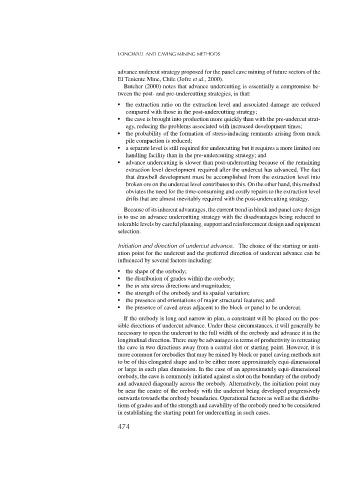Page 492 - Rock Mechanics For Underground Mining
P. 492
LONGWALL AND CAVING MINING METHODS
advance undercut strategy proposed for the panel cave mining of future sectors of the
El Teniente Mine, Chile (Jofre et al., 2000).
Butcher (2000) notes that advance undercutting is essentially a compromise be-
tween the post- and pre-undercutting strategies, in that:
the extraction ratio on the extraction level and associated damage are reduced
compared with those in the post-undercutting strategy;
the cave is brought into production more quickly than with the pre-undercut strat-
egy, reducing the problems associated with increased development times;
the probability of the formation of stress-inducing remnants arising from muck
pile compaction is reduced;
a separate level is still required for undercutting but it requires a more limited ore
handling facility than in the pre-undercutting strategy; and
advance undercutting is slower than post-undercutting because of the remaining
extraction level development required after the undercut has advanced. The fact
that drawbell development must be accomplished from the extraction level into
broken ore on the undercut level contributes to this. On the other hand, this method
obviates the need for the time-consuming and costly repairs to the extraction level
drifts that are almost inevitably required with the post-undercutting strategy.
Because of its inherent advantages, the current trend in block and panel cave design
is to use an advance undercutting strategy with the disadvantages being reduced to
tolerable levels by careful planning, support and reinforcement design and equipment
selection.
Initiation and direction of undercut advance. The choice of the starting or initi-
ation point for the undercut and the preferred direction of undercut advance can be
influenced by several factors including:
the shape of the orebody;
the distribution of grades within the orebody;
the in situ stress directions and magnitudes;
the strength of the orebody and its spatial variation;
the presence and orientations of major structural features; and
the presence of caved areas adjacent to the block or panel to be undercut.
If the orebody is long and narrow in plan, a constraint will be placed on the pos-
sible directions of undercut advance. Under these circumstances, it will generally be
necessary to open the undercut to the full width of the orebody and advance it in the
longitudinal direction. There may be advantages in terms of productivity in retreating
the cave in two directions away from a central slot or starting point. However, it is
more common for orebodies that may be mined by block or panel caving methods not
to be of this elongated shape and to be either more approximately equi-dimensional
or large in each plan dimension. In the case of an approximately equi-dimensional
orebody, the cave is commonly initiated against a slot on the boundary of the orebody
and advanced diagonally across the orebody. Alternatively, the initiation point may
be near the centre of the orebody with the undercut being developed progressively
outwards towards the orebody boundaries. Operational factors as well as the distribu-
tions of grades and of the strength and cavability of the orebody need to be considered
in establishing the starting point for undercutting in such cases.
474

